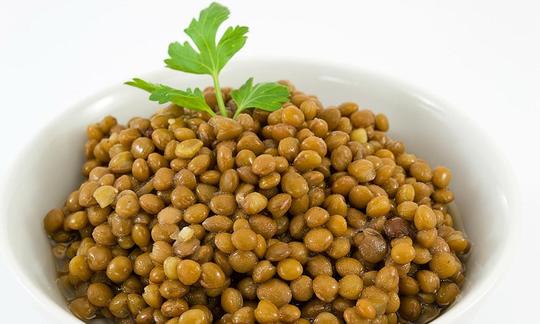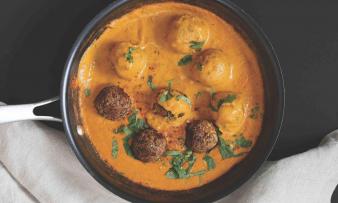Table of contents
Lentils ( Lens culinaris) are also known as kitchen lentils or seeds of the Erve. Due to their indigestible ingredients, they should not be eaten raw. Cooked or sprouted, they taste good even without salt and are an ideal filling meal.
Use in the kitchen:
Lentils with the skin on can be soaked in water overnight and then cooked in fresh water. This significantly reduces the cooking time. 1 We recommend cooking the lentils without salt, otherwise the skin can remain hard. But it is also a matter of taste. Make sure that the lentils are not boiling, but just simmering. Too much heat damages the vegetable protein. Acidic ingredients such as vinegar, lemon juice, wine, tomatoes or apples go very well with lentil dishes. However, these should only be added at the end of the cooking time. 2
Although lentils are easier to digest than their relatives ( beans, peas), they can still be hard on the stomachs of sensitive people. Combining lentils with herbs and spices such as savory, rosemary, thyme, sage, curry powder, ginger, cloves, garlic, coriander or chili can help your digestion. 2 Pureeing the lentils, as in certain lentil soups, makes them even easier to digest.
Cooked lentils taste excellent in soup, stew, casserole, salad or as a patty. Depending on the recipe chosen, different types of lentils are used. In German-speaking countries, lentils were not particularly popular in traditional cuisine. Only lentil recipes with soup vegetables, sausage and spaetzle were considered a speciality in parts of Germany. 3 However, their popularity is constantly increasing and they are now also being integrated into many traditional recipes. In Asia, lentils have long been an important staple food. Oriental dishes such as dals (dhal, daal) or curries often contain lentils as the main ingredient. A combination with rice completes these recipes in most Asian countries.
Baked goods and bread can be prepared with lentil flour. These gluten-free variants have a higher protein content than conventional flour, which is why they are often mixed.
Small lentils are particularly tasty and healthy because they contain more shell and the flavors are in the shell. Depending on the variety, lentils vary in size and color, but within the variety they are uniformly flat and round. You can buy red, green, yellow, brown, purple (violet) or black lentils. There are no strict rules governing the naming of lentils, which is why there is often confusion (see the "Shopping" chapter below).
Peeled lentils have lost flavors and nutrients through peeling, but also fiber in the form of triple sugars, which only bacteria can break down, causing flatulence in the large intestine. When cooked, peeled red lentils turn a yellowish color. Because they break down easily, they are ideal for puree, stews and soups. Unpeeled lentils, on the other hand, remain firmer and are better as a side dish or salad.
How many lentils for 2 people? For a pure lentil dish (eg dal) for two people, expect about 200 g of uncooked lentils and for a mixed dish, expect about 100-140 g of raw lentils. 5
Recipe for vegan lentil soup:
Ingredients: 1.5 l vegetable stock, 650 g potatoes, 1 leek, 230 g lentils (brown), 1 tbsp oil (e.g. rapeseed oil, refined), 1 pinchof pepper, 170 ml vegan cream (e.g. oat cream), 1 carrot, 2 onions, 1 pinch of sea salt.
Preparation: Bring the vegetable stock to the boil in a large pot. In the meantime, peel and chop the onions and fry them in oil in another pot until translucent. Add the lentils and fry briefly, stirring constantly. Deglaze with the hot stock and simmer covered for about 25 minutes. Peel the potatoes and cut into small pieces, wash the leek and cut into rings, peel the carrot and cut into slices. Add the vegetables to the lentils and cook for another 15 minutes until the vegetables are cooked. Stir in the cream and heat briefly, but do not boil. Season the lentil soup with salt and pepper and serve while still warm.
| Not only vegans or vegetarians should read this: Vegans often eat unhealthily. Avoidable nutritional errors. |
Shopping - where to buy?
Do you prefer lentils that are organically and locally grown? You can find organic lentils in organic shops, but also in some well-stocked supermarkets and in some major retailers such as Coop, Migros, Spar, Rewe, Edeka, Denner, Volg, Aldi, Lidl, Hofer etc. The latter, however, rarely stock organically produced, unpeeled lentils. You can also order the lentils you want online.
Lentils are not only differentiated by whether they are peeled or unpeeled or by color, but also by size: the smallest, known as sugar lentils, measure 4-5 mm. Medium-sized lentils have a diameter of 5-6 mm and plate lentils are between 6 and 7 mm in size. Even larger specimens are called giant lentils. Red lentils are usually smaller than green lentils.
If you go by color, a distinction based on the color of the kernel is widespread, especially in the agricultural sector. This separates green lentils (with yellow or green kernels) from red lentils (with red, orange or yellow kernels). Green lentils have a green seed coat, while red lentils have a darker one (depending on the country of origin). 14,15 For this reason, the trade also likes to refer to them as "brown" or "black lentils" and only the peeled, red or orange kernels as "red lentils."
The variety of lenses raises the question: which lenses for which purpose? Here is a selection: 6
- Lentils (large, mostly unpeeled and brown): also available as canned food; suitable for soups, stews, hearty dishes
- Mountain lentils (small, beige to brown): collective term for lentils from mountainous regions, remain firm after cooking; suitable for soups, stews, as a side dish to vegetables/meat, for salads, casseroles, patties
- Beluga lentils (very small, black): remain firm when eaten; suitable for soups, stews, salads, with vegetables
- Puy lentils (small, green): from the volcanic soil around Puy-en-Velay in France (AOP), hence also French lentils, do not overcook; suitable for curries, salads, with vegetables
- Pardina lentils (medium, brown): from Spain, wash thoroughly before cooking, remain firm; suitable for soups, stews, salads, spreads, starters
- Red lentils (small, peeled brown lentils, sometimes halved): quickly cooked, rather mushy; suitable for curries, dal dishes, puree, fritters, patties, sauces, spreads, soups, salads
- Yellow lentils (small, peeled green or brown lentils): quickly cooked; suitable for soups, salads, side dishes for vegetables, fish, meat, puree, spreads
Your own preparation:
Cooking lentils: Large lentils should be soaked overnight in six times the amount of water. If small lentils are older, it is recommended that you soak them too. If individual lentils float on the surface of the water, this is usually a sign that they are no longer suitable for consumption. These surface floaters are skimmed off and discarded. The next day, cook lentils in a saucepan in twice the amount of water (without salt). Use fresh water, which reduces flatulence and excessive foaming. The resulting foam comes from the saponins it contains and is not poisonous, it just tastes a little bitter. If you find the taste disturbing, the foam can simply be skimmed off. Make sure that about a third of the pan remains free. Reduce the heat so that the water is no longer boiling, but just simmering; you can also leave the lid off. How long the cooking takes depends on the size of the lentils. Large lentils (eg plain lentils) need about 30 minutes if you have soaked them beforehand. Without soaking, you should expect about 60 minutes. Small lentils (eg Beluga, Puy, mountain or Pardina lentils) need 20-30 minutes. Soaking doesn't make much difference here. It is important to keep an eye on the cooking time if you don't want lentil puree. 4 The red or yellow lentils sold in stores are peeled lentils and only need about 10-15 minutes to cook without soaking.
A dash of vinegar or a splash of lemon juice should intensify the flavor (add after cooking).
Storage:
Cooked, preserved lentils in a glass jar or tin are sealed and can be kept for several years if kept cool and dark. If the tin is opened, be sure to remove the lentils from the metal container, store in the refrigerator and use immediately.
If you have cooked too large a portion of a lentil dish, you should refrigerate or freeze the rest as quickly as possible. Germs can develop not only when reheating, but when stored incorrectly immediately after cooking. Cooked lentils will last up to 4 days in a sealed container in the refrigerator. Up to 6 months frozen. Lentils and other pulses can be reheated very well. Make sure the temperature is at least 70 °C and stir frequently. 7
Dried lentils will last a long time if stored in a dry, dark place in a sealed container. It is important that they are whole and unpeeled. The minimum shelf life is about one year. If you store them for a very long time, they may remain hard even after cooking.
Wild:
Sometimes you can find lentils growing wild on rubble heaps or wasteland. 3
Ingredients - nutritional value - calories:
How many calories are in 100 g of lentils? Cooked lentils have an energy content of 116 kcal/100g and therefore have even more calories than the starch-rich potato (87 kcal/100g). Cooked lentils score less for their vitamin content than for their amino acids and the complex composition of carbohydrates. To increase their biological value even further, it is best to eat them in combination with wholegrain rice. 8 Only folate as a folic acid-active substance group is worth mentioning at 181 µg/100g, as 100 g of cooked lentils cover almost 91% of the average daily folic acid requirement. 9 This is especially important for pregnant or breastfeeding women as their folic acid requirement is increased. Sprouted lentils provide more vitamins. For more information on the ingredients, please see the entry Lentils, raw.
Health aspects - effects:
Which lentils are healthy? Lentils are generally very healthy, especially those with the skin on. But it also depends on digestion. If you are very sensitive, peeled lentils are more pleasant to start with than those with the skin on. Once you have gotten used to peeled lentils, you can use unpeeled ones and gradually increase the amount. Lentils are very popular in vegan diets. Their high protein content and versatility mean they can replace meat products. The high fiber content means that the glycemic index of pulses is generally very low. The energy supply remains constant and so does the blood sugar level. This makes lentils ideal for diabetics.
Can you lose weight with lentils? Lentils are also an excellent food for people who are overweight and can help them lose weight without feeling hungry. 8
Secondary plant substances in the lentils (phenolic acids) help to absorb and excrete toxins from the intestines and thus reduce the risk of cancer. 10
Dangers - intolerances - side effects:
Lentils have a high proportion of purines for plant-based foods, which the body converts into uric acid and excretes through the kidneys. People with high uric acid levels or gout symptoms are advised to avoid foods rich in purines. This mainly applies to animal-based foods that contain purines. Plant-based foods can be consumed in moderation and with enjoyment. 11
Lentils are inedible in their raw form as they contain toxic ingredients (e.g. lectins). These can be rendered harmless by cooking. Soaking and the germination process can also reduce the toxicity sufficiently.
Pulses sometimes cause unpleasant flatulence, but lentils are the least harmful. This is due to the sugars they contain, which our small intestine cannot break down because the enzymes required are missing. Bacteria in the large intestine ferment these substances, which can produce gases.
Folk medicine - natural medicine:
Lentil puree applied externally can help with gout symptoms. To do this, let the cooked, pureed lentil pulp cool, put it in a small linen bag and place it on the painful area for about 20 minutes. 8
Occurrence - Origin:
The lentil probably originates from the wild lentil Lens orientalis from Asia Minor. Lentils have been cultivated since the Neolithic period, making them one of the oldest types of dried vegetables. 12 In the Neolithic period (approx. 7000 BC), the lentil was a major crop in the Fertile Crescent (Bulgaria, Greece). Lentils were also a staple food in ancient Egypt and Palestine.
According to Wikipedia, the most important growing areas are Spain, Russia, Chile, Argentina, the USA, Canada and the Middle East. In India alone, over 50 varieties are grown. 3
Cultivation - Harvest:
Lentils are legumes that bind nitrogen from the air with the help of nodule bacteria in the soil, which has a very positive effect on the soil. If other legumes have been grown in the field before, inoculation with nodule bacteria is not necessary.
Lentils are also very undemanding and can be grown on marly, sandy, calcareous and loose clay soils, which can also be quite shallow. They are considered to be weak competitors, which is why weed control in a pure culture is crucial for successful lentil cultivation. Depending on the climate and soil, there are also mixed cultures with oats or barley. Here it is important not to shade the lentils. Lentil cultivation in Europe is still a niche product and is more common in organic farming. 13
Lentils are harvested with a combine harvester, but it is difficult to determine the harvest time because lentils ripen very irregularly (from bottom to top). Therefore, the harvested lentils almost always need to be dried.
General information:
The kitchen lentil ( Lens culinaris) belongs to the legume family (Fabaceae). As an annual herbaceous plant, it grows between 10 and 50 cm high. 3
Other scientific synonyms are Lens esculenta Moench. or Ervum lens L. 1, the name Erve probably comes from the latter.
The UN declared 2016 the "International Year of Pulses".
Literature - Sources:
Bibliography - 15 Sources (Link to the evidence)
| 1. | Roger J. Heilkräfte der Natur. Ein Praxishandbuch. Zürich: Advent Verlag. 2006. |
| 2. | Avogel.ch Linsen. |
| 3. | Wikipedia Linsen. |
| 4. | Wir-essen-gesund.de Linsen kochen. |
| 5. | Reishunger.de Linsen pro Person. |
| 6. | Linsensorten.de |
| 7. | Praxistipps.focus.de Bohnen nochmal aufwärmen darauf sollten Sie achten. |
| 8. | Zentrum-der-Gesundheit.de Linsen - haltbar, sehr sättigend und überdies preiswert. |
| 9. | USDA United States Department of Agriculture. |
| 10. | Russell W, Duthie G. Plant secondary metabolites and gut health: the case for phenolic acids. Proc Nutr Soc. 2011;70(3). |
| 11. | Choi HK et al. Purine-rich foods, dairy and protein intake, and the risk of gout in men. N Engl J Med. 2004 11;350(11). |
| 12. | Zohary D. The wild progenitor and the place of origin of the cultivated lentil: Lens culinaris. Economic Botany. 1972;26(4). |
| 13. | bioaktuell.ch Anbau von Biolinsen. Erfahrungen in der Schweiz. |
| 14. | Yadav S., McNeil D. et al. Lentil: An Ancient Crop for Modern Times. Berlin: Springer Science & Business Media. 2007: 96-97; 384. |
| 15. | Samaranayaka A., Lentil. In: Nadathur S.R., Wanasundara J. et al. Sustainable Protein Sources, Elsevier. 2016. |









Comments